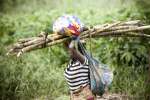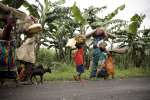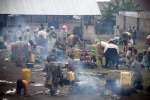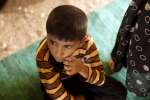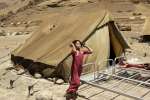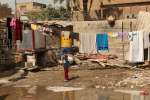Cross-border aid reaches 12,000 displaced civilians in western Libya
News Stories, 18 August 2014
TUNIS, Tunisia, August 18 (UNHCR) – The UN refugee agency has for the first time begun sending aid into western Libya from Tunisia to help some of the tens of thousands of people displaced by weeks of fighting in the Libyan capital, Tripoli.
A first convoy carrying urgently needed medical supplies and UNHCR relief items such as blankets, sleeping mats and nappies, was organized by the International Medical Corps (IMC) on Saturday. The two trucks set off from Medinine and crossed the border at Ras Ajdir before heading to the town of Zawiya, where some 12,000 people have sought shelter from the fighting in Tripoli, 45 kilometres to the east.
The IMC also sent a second convoy later Saturday of essential medicines and medical supplies to the displaced, who are living in very difficult conditions. Members of the Taher Al Zawia Organization have been distributing the aid.
"This weekend's operation is crucial and, we hope, paves the way for other humanitarian aid to reach affected populations who are stranded and in dire need of assistance," said Saado Quol, UNHCR's acting chief of mission in Libya.
UNHCR has a warehouse in Tripoli with stockpiles of critical relief items, but the agency cannot access these supplies because of the unstable security situation, which has hampered all its operations in the country since early July, including the provision of assistance to refugees and asylum-seekers.
Now in its fifth week of conflict, Tripoli is facing severe fuel and power shortages and this has disrupted services and the distribution of basic goods and supplies, including water, food, cooking oil, baby milk, supplies, and access to banking.
According to the International Federation of the Red Cross and Red Crescent Societies, at least 2 million people may be at risk of food shortages if the fighting continues in Libya.
The departure of foreign medical staff has exacerbated the situation. UNHCR, through the International Medical Corps, has provided essential medicine and other core relief items to several hospitals, but is also extremely concerned about the situation of asylum-seekers and migrants in detention centres.
During the first week of August, hygiene kits were provided to people rescued at sea and held in several detention centres in the coastal towns of Al-Khums, Misrata and Zliten. Relief items and medical assistance were also distributed by the IMC to evacuees who left areas hit by missiles and rockets in Tripoli.
The Crisis Committee of the Tripoli City Council estimates that some 7,240 families (around 43,500 people) have been displaced by the weeks of fighting in the Libyan capital. Some sources estimate the figure may be much higher.
Although many families have sought shelter with friends and relatives in other cities, some have nowhere to go and are living in woods and open areas outside Tripoli. "These people cannot go further to the west as the road is increasingly unsafe, and they cannot go back to the east," UNHCR's Quol noted, adding: They are in urgent need of assistance and, despite the challenges, we need to be able to respond to the needs of affected civilians."
By Dalia Al Achi in Tunis, Tunisia





